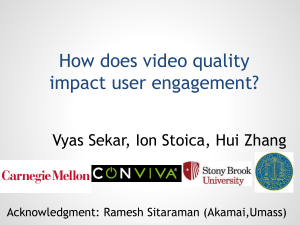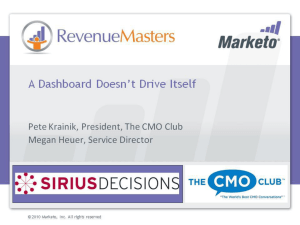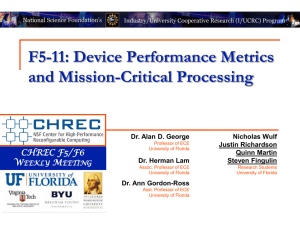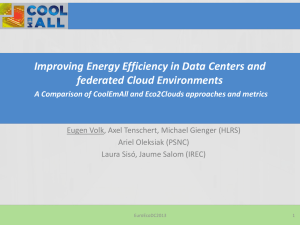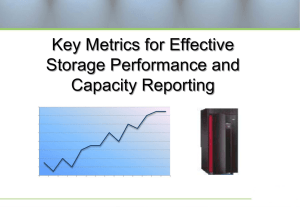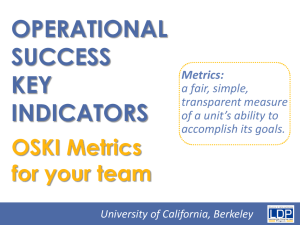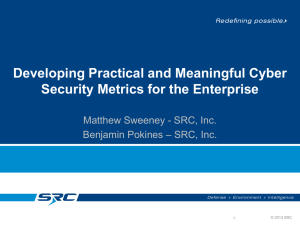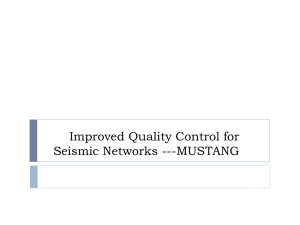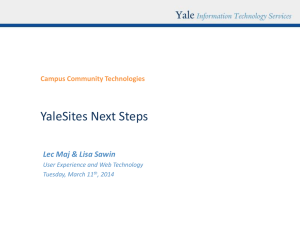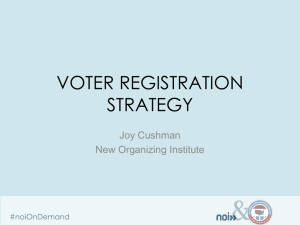Metrics & Dashboards
advertisement
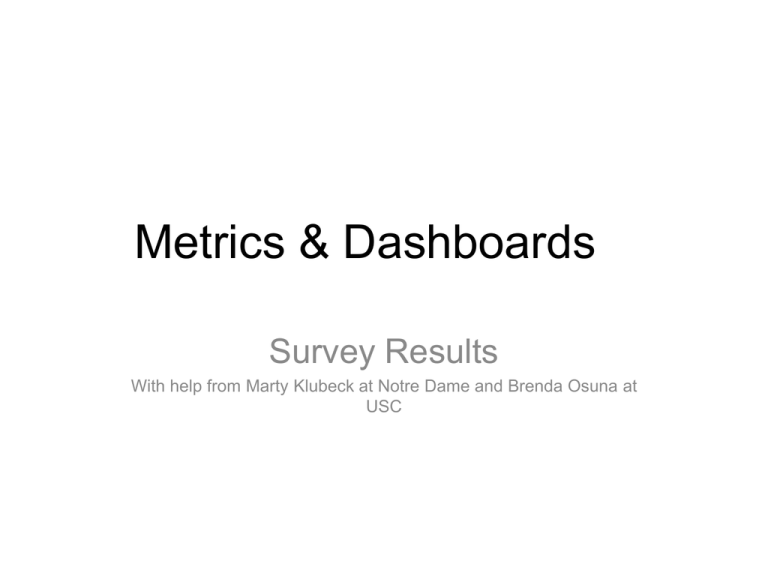
Metrics & Dashboards Survey Results With help from Marty Klubeck at Notre Dame and Brenda Osuna at USC Who are we? Brown Carnegie Mellon Columbia Cornell CU-Boulder Duke University Georgetown University Harvard* Michigan State University New York University Penn State Princeton Stanford University UC San Diego UCSF University of Chicago* University of Iowa University of Michigan University of Minnesota University of Notre Dame University of Washington University of Wisconsin Virginia Tech 2 How often do we collect the following types of metrics around service health (effectiveness)? 80% 59% 60% 48% 45% 40% 34% 31% 26% 25% 20% 10%10% 14% 7% 6% 30% 33% 11% 9% 0% Demographics Usage/demand Performance Customer Satisfaction Weekly/Daily/Continuously Monthly or by Semester Annually Less frequently than annual or not at all 3 For what services do we collect metrics? 100% 80% 60% 40% 33% 29% 29% 20% 10% 0% 0% Most of our services A few services Good news is that no one said zero! Only key services All of our services No metrics collected 4 And, our metrics to measure business efficiency and delivery of goals? 100% 80% 60% 40% 20% 0% Time (speed of delivery) Cost Quality (defect/error rates) Other OTHER: 1) It widely varies depending on the service 2) We do not collect any business efficiency metrics 3) Project delivery # of calls abandoned; # change requests; # e-mails; # abandoned calls, resolution time, cycle time, abandonment, etc.; capacity, mean time to repair 5 Our use of targets 100% 80% 68% 60% 40% 63% 53% 32% 21% 20% 16% 0% Expectations Targets based Expectations Targets based Other (please We don’t use based on our on specify) based on our on our peers’ any Service-Level- historical/trend customers’ performance demarcation of Agreements data requests/needs “health” OTHER: 1) Working on the use of ITIL Information Technology Infrastructure Library 2) Note: we don't do this consistently though 3) We do not use any service target range metrics 4) Industry Practices / Standards 6 Metrics are collected and analyzed primarily as… 100% 80% 67% 60% 43% 40% 20% 10% 5% 0% Grass roots Organizational/departmental effort Institutional effort effort Other (please specify) OTHER: System performance metrics in transition to organizational effort. 7 Who is the audience for our metrics? 95% 100% 95% 80% 67% 60% 43% 40% 38% 29% 20% 0% Internal IT staff OTHER: Post publicly IT management University executive leadership Your user community Peers in other institutions (for benchmarking) Other leadership 8 How do we share them? 100% 80% 67% 60% 53% 40% 40% 33% 27% 20% 0% Published for Other (please the organization specify) (Intranet) Published publicly (web with open access) Directly to Published for customers current and (electronic or potential hardcopy customers (web reports) with controlled access) 9 20% OTHER: 1) right-sizing the organization; metrics enable us to tune documentation and training and better prepare support providers Other 60% Early-warning-system, enabling us to prevent problems Insights to the causes of problems or innovations 71% Improvements 71% Communicate better with our leadership 80% Communicate better with our customers Made process/project adjustments Benefits so far 100% 81% 71% 62% 43% 40% 10% 0% 10 How do we rate the maturity of our organization’s use of metrics? 100% 80% 60% 52% 40% 33% 20% 10% 0% 0% Fully Mature 5% 0% Maturing Managed Developing Novice Totally novice 11 Our use of external data sources 100% 84% 80% 72% 68% 77% 56% 60% Compare data to 40% 28% 20% Provide data to 23% 16% 17% 8% 8% 11% Don't use 0% Educause Core Data Use for defining metrics IPEDS OTHER: 1) Gartner for Benchmarking 2) Used to participate in the campus computing survey 3) Gartner COFHE 12 Any BI action? 100% 80% 60% 45% 40% 30% 15% 20% 10% 5% 0% Have considered Have not considered In the process Have a of developing functioning BI environment OTHER: Currently considering an environment, platform selection pending Other 13 Our biggest challenges 67% 43% 33% 33% Other (please specify) Lack of consistent comparison/benchm ark data Lack of expertise in data analysis Lack of expertise in the development of metrics Lack of automated collection tools 14% 5% Lack of support from leadership 81% Lack of dedicated resources 100% 80% 60% 40% 20% 0% OTHER: 1) Continuing engagement from mid-level leadership to respond to metrics findings 2) Organizations ability to identify specific KPI's to measure specific objectives 3) Changing leadership/definition of what is necessary and relevant; metrics must mean something to be used effectively; lack of a plan; staff resent 14 What would we find useful? 0% 20% 40% 60% 80% 90% Standard definitions 68% Guidelines on developing/reporting 63% A template for basic metrics 58% Review by peers of possible tools 37% On-call expertise Other (please specify) 100% 11% OTHER: 1) None of the above 2) Unified approach to metrics from an organizational perspective; lack of a plan; dedicated resources would be better. No one is going to use another template and different services would be measured by different metrics unless the metrics were provided at a very very very high level 15 Tools – what have we used, what do we think? 20 95% 100% 18 16 80% 14 12 11 60% 44% 10 8 40% 2 6 2 5 4 2 0 38% 1 6 4 41% 1 Excel 2 Cognos 18% 13% 3 1 1 1 1 2 SPSS SAS Other BSC Inadequate Fair Good 20% 13% 2 7% 7% 1 1 Power Pivot SigmaXL Excellent Tableau 0% 0% iDashboard Vision 0% Outstanding “Believe that the process and commitment to consistent data collection is far more important than the tool” Used 16 Lessons learned • Metrics have helped to highlight areas of significant service difficulties (e.g., with BlackBerry services) and to note some low-level points of problems (e.g., around some of our network measures.) At the same time, our current metrics processes are highly manual in nature and require significant time investment to collect and report. We have seen challenges in getting service management engaged on the data writ large, which can lead to problems when errors due to service changes are missed thus impacting trending. Goals for us in coming year include focusing on trend analysis/reporting through executive summarization (done), gaining more mileage out of system-generated metrics on availability and low-level alarms, improving automated collection of non-availability data, and looking to focus data aggregation of human-generated, automated and other data into a dashboard to reduce effort level required to visualize service data. • Benchmarking is very challenging because of the variance environments at each institution. Cost components may be different, service features and SLAs may not match, accounting practices can be problematic, tracking labor is different, etc. 17 Lessons Learned • We had a nascent metrics program under development with dedicated resources, focusing on helping service managers to develop metrics with their local data. With the departure of that resource in October, we are choosing to re-prioritize the work away from dedicated attention to metrics at this time. Instead, we watch with great interest the aggressive agenda that EDUCAUSE has developed with the reinvigoration of ECAR under Susan Grajeck. We will continue to monitor the progress of the various EDUCAUSE initiatives around research, data, and analytics and pursue collaboration opportunities based on our own priorities and resources. • We did quite a push to get a metrics dashboard going a couple of years ago which was quite successful. However, the backend work of building a data metrics repository was never completed. This has limited us from getting deeper analytics questions answered and still requires us to perform manual queries often. On the other hand, when we recently needed to pull together a metrics dashboard for a large client (a hospital) we were able to reuse much of the work we had done previously. 18 Lessons Learned • We collect a lot of operational performance data using traditional tools (Cricket, Nagios, home-grown scripts) but don't have a reasonable dashboard or approach to making the data useful. We have recently started measuring performance of our service desk and groups behind them to track delivery against SLAs in our service catalog. We've started a Service-Now implementation and expect to use metrics delivered by that tool. • Challenge getting consistent operational definitions both for internal use and benchmarking; Data collection is still a time consuming, manual process that we are working to automate through the collection of metrics from disparate systems into a BI environment; We are exploring the use of Microsoft BI tools (e.g. PowerPivot, SQL Server 2012, PowerView) 19 THANK YOU 20

